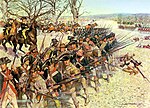Jethro Exum Sumner (c. 1733 – c. March 18, 1785) was a senior officer of the Continental Army during the American Revolutionary War. Born in Virginia, Sumner's military service began in the French and Indian War as a member of the state's Provincial forces. After the conclusion of that conflict, he moved to Bute County, North Carolina, where he acquired a substantial area of land and operated a tavern. He served as Sheriff of Bute County, but with the coming of the American Revolution, he became a strident patriot, and was elected to North Carolina's Provincial Congress.
Sumner was named the commanding officer of the 3rd North Carolina Regiment of the North Carolina Line, a formation of the Continental Army, in 1776, and served in both the Southern theater and Philadelphia campaign. He was one of five brigadier generals from North Carolina in the Continental Army, in which capacity he served between 1779 and 1783. He served with distinction in the battles of Stono Ferry and Eutaw Springs, but recurring bouts of poor health often forced him to play an administrative role, or to convalesce in North Carolina. Following a drastic reduction in the number of North Carolinians serving with the Continental Army, Sumner became a general in the state's militia but resigned in protest after the North Carolina Board of War awarded overall command of the militia to William Smallwood, a Continental Army general from Maryland. At the end of the war in 1783, Sumner helped to establish the North Carolina Chapter of the Society of the Cincinnati, and became its first president. He died in 1785 with extensive landholdings and 35 slaves.




